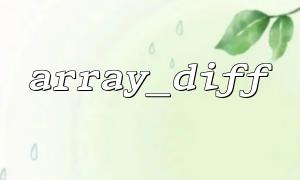In PHP, array_diff() is a very common function that can find the differences between arrays. But when we use it to process associative arrays in actual projects, if we do not understand how it works, we may fall into many "pits".
This article will explain in-depth the behavior of array_diff() , common misunderstandings, and some practical techniques in associative array processing.
$array1 = ['a' => 'apple', 'b' => 'banana', 'c' => 'cherry'];
$array2 = ['a' => 'apple', 'b' => 'blueberry'];
$result = array_diff($array1, $array2);
print_r($result);
Output:
Array
(
[b] => banana
[c] => cherry
)
Explanation: array_diff() only compares "value" and ignores the key name . In this example, although the keys of $array1['b'] = 'banana' are the same as $array2['b'] = 'blueberry' , 'banana' is considered one of the differences due to the different values.
Misconception: Many developers think array_diff() will compare key-value pairs.
$a = ['id' => 1, 'name' => 'John'];
$b = ['name' => 'John', 'id' => 2];
var_dump(array_diff($a, $b));
Output:
array(1) {
["id"]=>
int(1)
}
Although 'name' => 'John' is the same in both arrays, because array_diff() does not look at the key, it only focuses on whether the value exists. So 'id' => 1 is considered different because 1 is not in the value of $b .
? Solution: If you want to compare keys and values at the same time, it is recommended to use array_diff_assoc() :
array_diff_assoc($a, $b);
It will compare keys and values at the same time, avoiding this "illusion".
$a = ['value1' => 123];
$b = ['value2' => '123'];
print_r(array_diff($a, $b));
Output:
Array
(
)
Pit point: array_diff() uses a strict comparison of right or wrong ( == ), so 123 and '123' are considered the same.
? Tip: If you need strict comparison (the values and types must be consistent), you can use array_diff() 's variant array_diff_uassoc() with a custom comparison function.
$result = array_udiff($a, $b, function($a, $b) {
return $a === $b ? 0 : ($a > $b ? 1 : -1);
});
array_diff() is a one-dimensional array tool , and for multi-dimensional arrays it does not compare recursively.
$a = ['info' => ['id' => 1, 'name' => 'Tom']];
$b = ['info' => ['id' => 1, 'name' => 'Tom']];
print_r(array_diff($a, $b));
Output:
Array
(
[info] => Array
(
[id] => 1
[name] => Tom
)
)
Cause: The value of the array type is treated as a string in array_diff() , and it cannot directly compare whether the contents of the two arrays are equal.
? Solution: If you want to compare multi-dimensional arrays, you need to write recursive functions manually, or compare them with serialization conversion:
$a_serialized = array_map('serialize', $a);
$b_serialized = array_map('serialize', $b);
$diff = array_diff($a_serialized, $b_serialized);
Suppose you pull a piece of data from the database to $original , the user submits a form to $new_data , and you want to know which fields have changed:
$original = ['name' => 'Alice', 'email' => 'a@m66.net'];
$new_data = ['name' => 'Alice', 'email' => 'alice@m66.net'];
$changed = array_diff_assoc($new_data, $original);
This way you can accurately obtain which fields have been changed by the user.
You have two configuration arrays $config1 and $config2 :
$config1 = include 'http://m66.net/config/old.php';
$config2 = include 'http://m66.net/config/new.php';
$diff = array_diff_assoc($config2, $config1);
This allows easy access to configuration changes, especially suitable for writing in automated scripts.
| method | Compare content | Whether to distinguish between types | Suitable for scenes |
|---|---|---|---|
| array_diff() | Compare values only | no | Simple value comparison |
| array_diff_assoc() | Compare value + key name | no | Form, configuration comparison |
| array_udiff() | Custom comparison method | Customizable | Strict type comparison |
| serialize + array_diff() | Multidimensional array comparison | No (scalable) | Multidimensional structure comparison |
When using array_diff() , be clear about what you are comparing. Don't be misled by key names, and don't forget the impact of the type. Only by understanding these principles can you truly use this tool function.
If you encounter special comparison needs in your project, please write a gadget function encapsulation logic by hand - this not only improves the readability of the code, but also reduces the probability of breaking into a pit.















